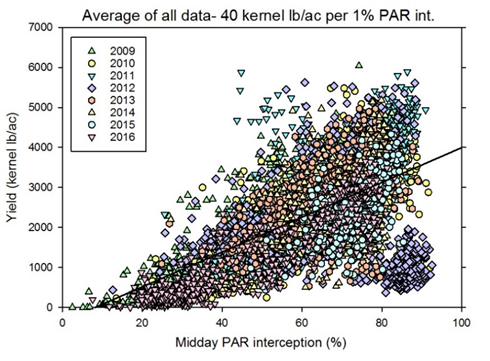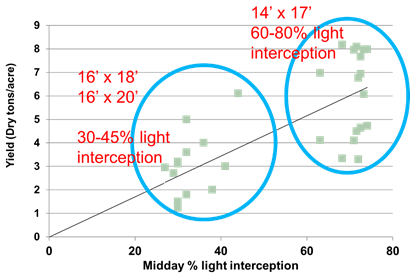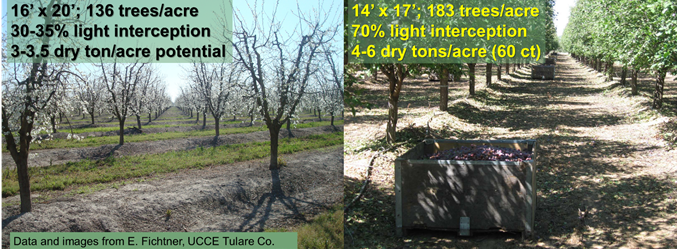Luke Milliron, UCCE Farm Advisor, Butte, Tehama, and Glenn Counties; Franz Niederholzer, UCCE Farm Advisor, Colusa, and Sutter-Yuba Counties; Dani Lightle, UCCE Farm Advisor, Glenn, Butte, and Tehama Counties; Katherine Jarvis-Shean, UCCE Farm Advisor, Yolo, Solano, and Sacramento Counties
Increased Canopy Volume -> Increased Light Interception -> Increased Yield Potential
Many of California’s established prune orchards are falling short of the land’s yield potential. Higher yields could be achieved by capturing more light with the choice of a more vigorous rootstock, and/or planting at a closer spacing. We all know that fruit and leaves grow on branches, and that fruit need the sugar production from neighboring leaves to grow and sweeten. Thus, one way to think about the yield potential of an orchard is how many fruit-leaf groupings (also called bearing units) are spread out over the orchard. In other words, increasing the amount of space in the orchard taken up by the orchard canopy (instead of open, unused space) will increase your yield potential per acre.
One measure of canopy size is how much light that canopy intercepts. Light that is intercepted by the leafy canopy and doesn’t reach the orchard floor is measured as midday photosynthetically active radiation (% PAR). Work by the laboratory of Bruce Lampinen, UCCE Orchard Specialist at UC Davis, has found that for every 1% of light that an almond orchard captures there is an average of 40 lbs/ac increased yield in all measured orchards (see figure 1). Lampinen has found this relationship between greater light capture and greater yield potential in both almond and walnut production. Light interception isn’t the only determinant of yield of course, therefore these are “potential” yields and depend on proper irrigation, fertilization, pest and disease management.

Figure 1. Measuring both almond yield (kernel lbs/ac) and midday photosynthetically active radiation (PAR) percentage have shown a direct relationship of 40 kernel lb/ac per 1% PAR (courtesy of Lampinen Lab, UC Davis).
Light Interception and Yield Potential in Prune Production
Although the relationship between canopy light interception and yield has not been as well studied in prune production, there does appear to be a clear relationship from the limited data available (see Figure 2). Although there is substantial variation, the denser 14’ x 17’ planting in this example is achieving between 60-80% light interception and is clearly out yielding the wider spaced plantings that are only capturing 30-45% of midday light, common in many California prune orchards. The 16 foot in-row spacings of the wider plantings appear as discrete trees (they do not touch), while the 14’ x 17’ spacing have created continuous hedgerows (see figure 3). This tighter 14’ x 17’ (183 trees/acre) spacing illustrates the 6-8 dry tons/ac yield potential of prune orchards in excellent cropping years. Industry spacing preference does appear to be moving towards higher density tree spacings; at a recent UCCE prune meeting, the top three spacing choices voted on by attendees were 14’ x 18’, 14’ x 16’, and 16’ x 18’. Finally, unlike almond and walnut production, fruit size is critical to profitability in prune production and therefore the most profitable growers have a shaker thinning program in years with good set (e.g. 60 ct average of 14’ x 17’ orchard in figure 3).

Figure 2. Two clusters of prune yield (dry tons/acre) versus midday light interception (%), grouped by row spacing (courtesy of E. Fichtner and F. Niederholzer).
Prune orchard spacing has historically been determined by the constraints of harvest equipment. However, some growers are instead shifting this paradigm and beginning to modify their equipment to get through tighter spacings. Many questions and potential challenges arise due to this shift in paradigm and will be addressed through experimentation by innovative growers and UC researchers.

Figure 3. Two orchards with contrasting spacing, light interception and yield potential (courtesy of E. Fichtner and F. Niederholzer).
Spacing/Light Interception Factors to Consider
- Soil: Spacing selection should always be made in the context of land capability and rootstock selection. Generally, tighter tree densities should be considered on more marginal land, tree canopies have a greater ability to “fill the space” at a slightly wider spacing on good ground.
- Rootstock: Matching vigor of the rootstock with soil type and spacing is a tough challenge at planting. Other considerations include anchorage, suckering, and tolerance to bacterial canker. Read more on rootstock trial performance of anchorage & suckering and on vigor/yield and survival against bacterial canker.
- Site, equipment, operation and expense: Tighter spacings warrant careful concern regarding equipment clearance and risk of field worker injury. While wider row spacings require fewer passes per acre for insecticide and fungicide applications or harvest operations. Establishment costs such as irrigation design – length of irrigation line and risers – also increases with a tighter row spacing.
- Per tree costs: Any activity performed on a per-tree basis – planting, wrapping, pruning, tying, painting, suckering, etc. will have higher costs with a greater number of trees per acre.
- Hedging: The cost of hand pruning is one of the top concerns of prune growers, and per tree costs of tree training and hand pruning mean this expensive cost only increase at the new higher planting densities. These high per tree costs are moving some growers mechanical hedging programs once tree structure with hand pruning has been completed and orchards are producing. However, mechanical hedging creates thousands of indiscriminate pruning wounds that are susceptible to Cytospora and other fungal cankers. Read more on hedging considerations here.
Interplanting: Prune orchards have historically been planted at wide spacings (24’ x 24’, 22’ x 22’, 20’ x 20’, etc.) and growers have attempted to increase light interception by interplanting down the tree row, or even on the diagonal. However, interplanting creates a very difficult situation for successfully establishing new trees due to poorly optimized irrigation, and especially the high risk of fungal canker infection in a high inoculum environment. Consider starting over with proper site preparation and establishment practices, instead of interplanting. Here’s more information on the risk of interplanting.
Special thanks to Mark Gilles (Sunsweet) for his input on prune orchard spacing both historically and currently.


Leave a Reply